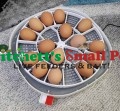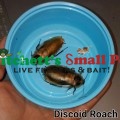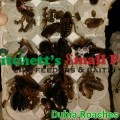 Loading... Please wait...
Loading... Please wait...- Home
- Live Feeders
- Roaches
- Discoid Roach (Blaberus discoidalis)
Product Description
from wikipedia...
Blaberus discoidalis, commonly known as the discoid cockroach,[2] tropical cockroach,[3] West Indian leaf cockroach,[3] false death's head cockroach,[4][5] Haitian cockroach,[6] and drummer,[7] is a cockroach native to Central America of the "giant cockroach" family, Blaberidae.[6][8]
Adults are around 35–45 mm (1.4–1.8 in) in length, and are tan with a dark brown to black patch on their pronotum.[6] Juveniles are brown with tan speckles, and mature to adulthood in 4–5 months.[6] Adults have wings but are not active fliers,[6] and they can not climb smooth vertical surfaces, simplifying their care in captivity.
B. discoidalis is called the false death's head cockroach because of its superficial resemblance to the death's head cockroach, Blaberus craniifer.
Contents
[hide]
1 Distribution2 Locomotion3 Uses 3.1 Pet food3.2 Fuel cell
4 References
Distribution[edit]
Adult and juvenile specimens at Smithsonian National Zoological Park
B. discoidalis are found in Jamaica, Cuba, Haiti, Puerto Rico, Puerto Rico (Vieques Island), Panama, Colombia, Venezuela, Trinidad and Tobago (Trinidad), and USA (Florida).[7]
Locomotion[edit]
The movement of B. discoidalis is relatively slow and inefficient compared to the common cockroach Periplaneta americana, which sprints on its hind legs more than twice as fast at 50 body lengths per second.[9] In laboratory tests, specimens were adept at obstacle climbing, and maintaining stability with miniature "cannons" strapped to their bodies to knock them off balance.[9] The species served as the basis for the kinematics design of a several cockroach-inspired robots.[10][11]
Uses[edit]
Pet food[edit]
They are very easy to raise in captivity and therefore make good food for insectivorous pets such as tarantulas, bearded dragon and other lizards.
Discoid cockroaches also produce considerably less odor than crickets, another common feeder animal. They can survive on many substrates and to some extent they will clean their own cage, only requiring cleaning on a monthly basis or less. Coconut fiber makes a good substrate as the nymphs readily burrow in it, and it holds humidity well.
Most high protein food sources are sufficient to maintain them, such as dry dog food. They can eat and should be given a variety of fresh fruit and vegetable scraps. Keep their food in a dish (or two) dry food and wet/fresh separate. On the opposite side of the tank keep and auto water dish or just a shallow water dish and replace when empty or dirty. Keep the roaches on mulch or peat and give them egg crates to spread out on. Also even though they can not climb glass they can climb silicone and will climb the corners of the aquarium. If they get out they will desiccate if not given a water source, thus reducing the risk of infestation.
These animals breed readily in captivity. They reach breeding age in about 6 months if kept warm, with 85°F-90°F being recommend for more productive breeding. Females will carry their eggs inside a brooding pouch within their abdomen until they hatch.
Nutritional requirements differ between juvenile and adult B. discoidalis, evidenced by proportions of volatile fatty acids in specimens fed the same dog food diet.














